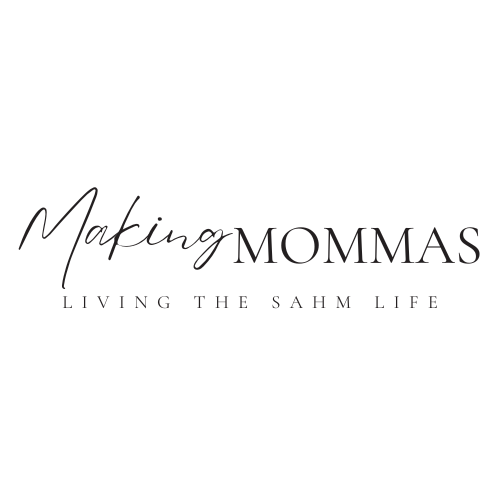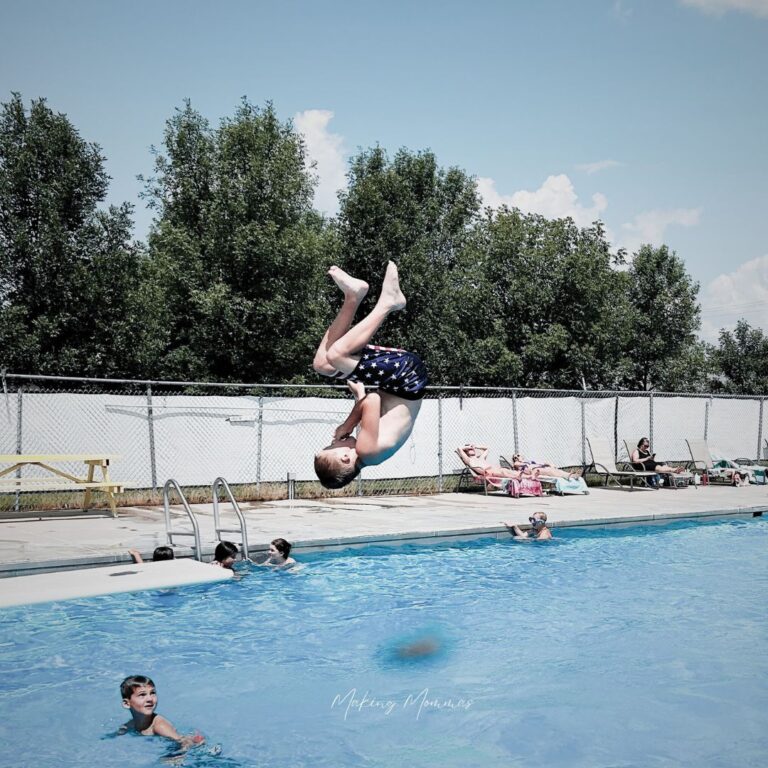In this article:
Toggle- How to create a daily routine for your toddler schedule
- Sample Toddler Schedule for 18 Month Old
- Sample Stay at Home Schedule for 2 Year Old
- Sample Schedule for 3 Year Old
- How to Write Down Your Own Stay at Home Mom Schedule
- Tips for Creating a Stay at Home Mom Schedule for Toddlers
- Sahm FAQs
- At the End of the Day…
- Before You Go!
- More on Stay at Home Mom Schedules
Struggling to create a stay at home mom schedule that works for you and your 18 month old? In this post, learn all the tips and tricks from this experienced momma on how to make it work!
Feeling frustrated by the daily chaos as a stay-at-home mom with an 18-month-old?
Don’t worry, momma, lots of stay at home moms find this age challenging! Many sahms struggle to find a practical and flexible routine for themselves and their toddler.
I know I did!
As a mom of twins, I learned the hard way what not to do – and what to do instead! So, I’ve got a few ideas and tricks up my sleeve. 😉
I’ll help you create a stay-at-home mom schedule that you can stick to consistently.
This schedule will not only meet your child’s developmental needs but also give you some much-needed ‘me’ time.
So let’s dive in and discover the path to a more organized and peaceful day-to-day life with your 18-month-old!
Momma’s Mini-Guide

I know you’re super busy, momma, juggling endless tasks like feeding, changing, playing, and teaching, so here’s my short and sweet version:
Identify Your Child’s Rhythms: Every child is unique, so observe your child’s natural rhythms – when they are most active, when they sleep, etc. – and plan your toddler schedule around these rhythms.
Prioritize Routine Over Rigid Schedules: It’s not about sticking to rigid timelines, but more about establishing a consistent routine that both you and your child can predict.
Include ‘Me’ Time: As a stay-at-home mom, it’s crucial to incorporate self-care practices into your day. Whether it’s reading, exercising or simply enjoying your coffee, this time is essential for recharging and maintaining your wellbeing.
Flexibility is Key: While routines are important, so is flexibility. Be prepared to adapt as your child’s needs change, and always leave room for spontaneous fun!
Seek Support: Whether it’s from your partner, family, friends, other moms, or mom groups online, don’t hesitate to seek advice and support. You’re not alone in this journey!
Pin this article to come back later and read the rest! (Like, while you’re nursing baby! 😉)
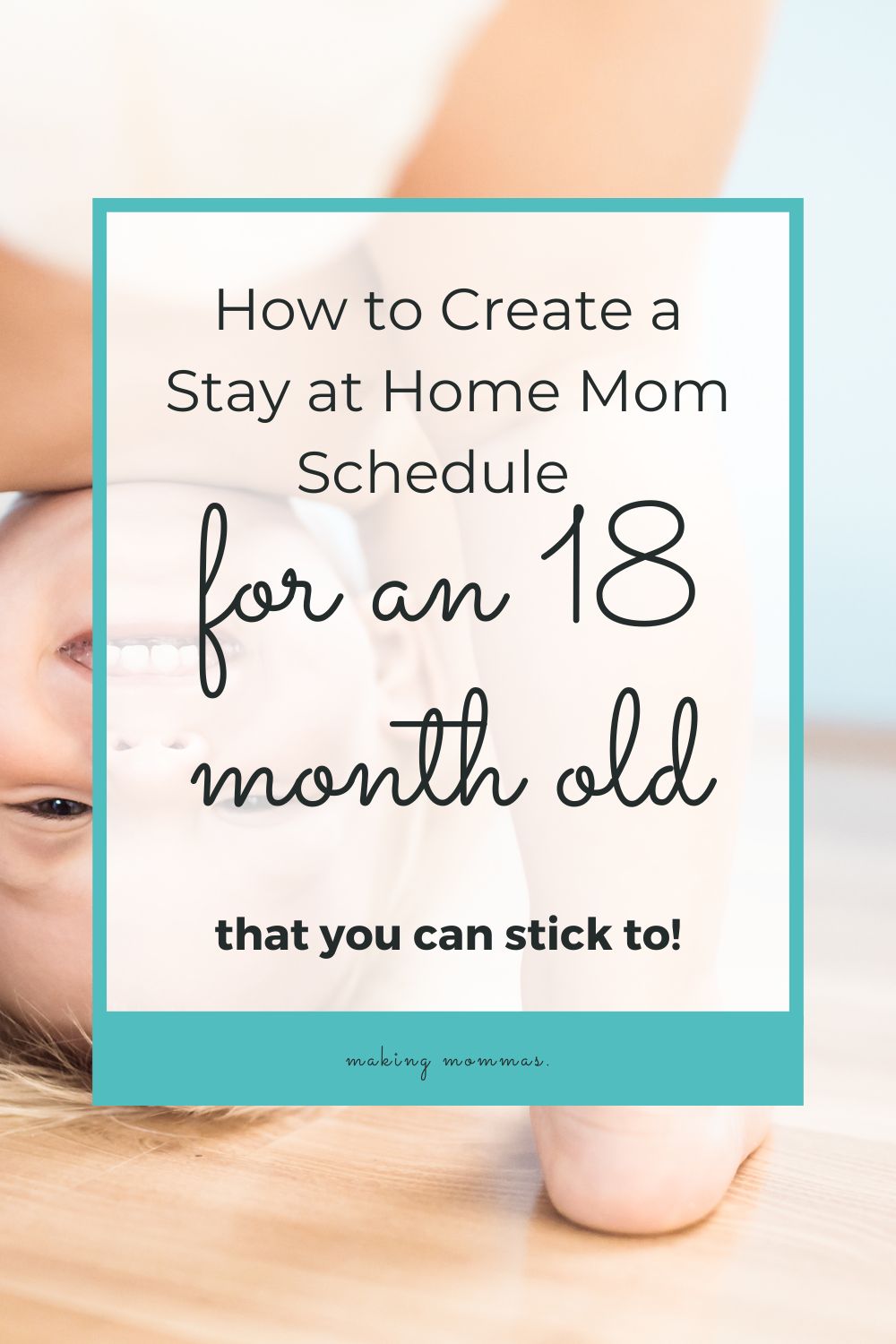
How to create a daily routine for your toddler schedule

Before we dive in, let’s talk about the difference between a ‘schedule’ and a ‘routine’, momma.
They may sound similar, but they have different implications, especially when it comes to managing the daily life of an 18-month-old.
A ‘schedule’ is more rigid, with activities planned down to the minute.
On the other hand, a ‘routine’ is a set of habitual activities that happen around the same time but with some flexibility.
For toddlers, consistency and predictability are important. They thrive on routines, not strict schedules.
A routine helps your toddler know what’s coming next, reducing tantrums and creating a sense of security.
So, instead of sticking to a strict family schedule, let’s focus on creating a flexible yet consistent daily routine for your little one.
Now, let’s check out the steps to creating that perfect day for you and your 18-month-old!
1. Create a morning routine

Having a simple routine every morning is super important because it sets the tone for the rest of the day.
A well-planned morning routine can help your little one wake up smoothly and be ready to tackle the day with a positive attitude.
Here’s how you can create an awesome routine for your mornings:
First things first, wake up at the same time every day. This helps regulate your toddler’s body clock and ensures they get the right amount of sleep.
Next, have a series of fun yet predictable activities like brushing teeth, getting dressed, and having breakfast.
After breakfast, make sure to squeeze in some playtime. You could read a cool book together, build stuff with blocks, or even get artsy with some drawing or painting. Not only does this help with your toddler’s brain development, but it also keeps them in a happy mood.
Maintaining a consistent order of activities every day like this creates what I like to call “mini routines.”
These little routines can be as simple as always brushing your teeth right after breakfast or reading a book right before nap time.
The great thing about these mini routines is that they make toddlers feel secure and comfortable. As they start to understand the sequence of events, they know what’s coming next and what to expect from their environment.
This not only helps reduce their anxiety about the unknown but also gives them a sense of control, making them feel safe and secure.
Remember, the key to a successful routine is being consistent, even in the morning. It might take a little while for your little one to adjust, but once they do, mornings will become way less chaotic and a lot more fun for both of you!
2. Create an afternoon routine

It’s just as important to create an afternoon routine for your toddler, to keep their energy levels and mood in check throughout the day.
A well-structured routine helps avoid over-tiredness, tantrums, and trouble falling asleep at night.
Here’s how you can set up a great routine for your afternoon:
First, have lunch at the same time every day, followed by some quiet playtime. Think puzzles, coloring, or playdough – activities to help your little one wind down before their afternoon nap.
Speaking of naps, they’re super important for recharging! Make sure your toddler has their nap at a consistent time every day to help regulate their body clock.
After the toddler wakes from nap, keep them engaged with fun activities or a snack before transitioning into the evening routine.
Remember, flexibility is key. Adjust the routine as needed to meet your child’s changing needs. Consistency is great, but always listen to the cues your child is giving you.
3. Create an evening routine

Creating an evening routine is important too, because it promotes a sense of security and improves sleep.
Children thrive on consistency, and an established evening routine provides predictability, helping your toddler understand and learn what to expect as the day ends.
Here’s how to create an effective evening routine:
Start off with a nutritious dinner at a fixed time, followed by play time to let your toddler burn off any extra energy.
As bedtime approaches, shift to quieter activities like reading a book or doing a puzzle to help them wind down.
Then, it’s bath time! Changing into cozy pajamas and brushing those tiny teeth are important steps too, instilling good dental habits from an early age.
Lastly, create a pleasant and calming bedtime ritual.
Rituals are super important in a child’s life! They bring stability and consistency, creating a safe and trusting environment.
It’s not just about daily routines – rituals give kids a sense of belonging and identity. They help little ones make sense of the world around them and grow.
Plus, rituals create special bonds and memories that can last a lifetime.
They make ordinary moments extraordinary, adding purpose and meaning to everyday life. Through rituals, kids learn valuable life skills, cultural norms, and how to be responsible.
Some great bedtime rituals might be reading their favorite book, singing a lullaby, or simply chatting about the day.
Remember, patience and consistency are key to a successful evening routine. Some nights may not go as planned, but sticking to the routine as much as possible will make bedtime smoother and ensure better quality sleep for your toddler.
To sum it up, mini-routines and rituals are super important in structuring the daily schedule for an 18-month-old.
These practices not only keep things consistent but also make every day feel special. And most importantly, they help toddlers explore, learn, and develop important life skills while building strong bonds and creating precious memories.
Sample Toddler Schedule for 18 Month Old
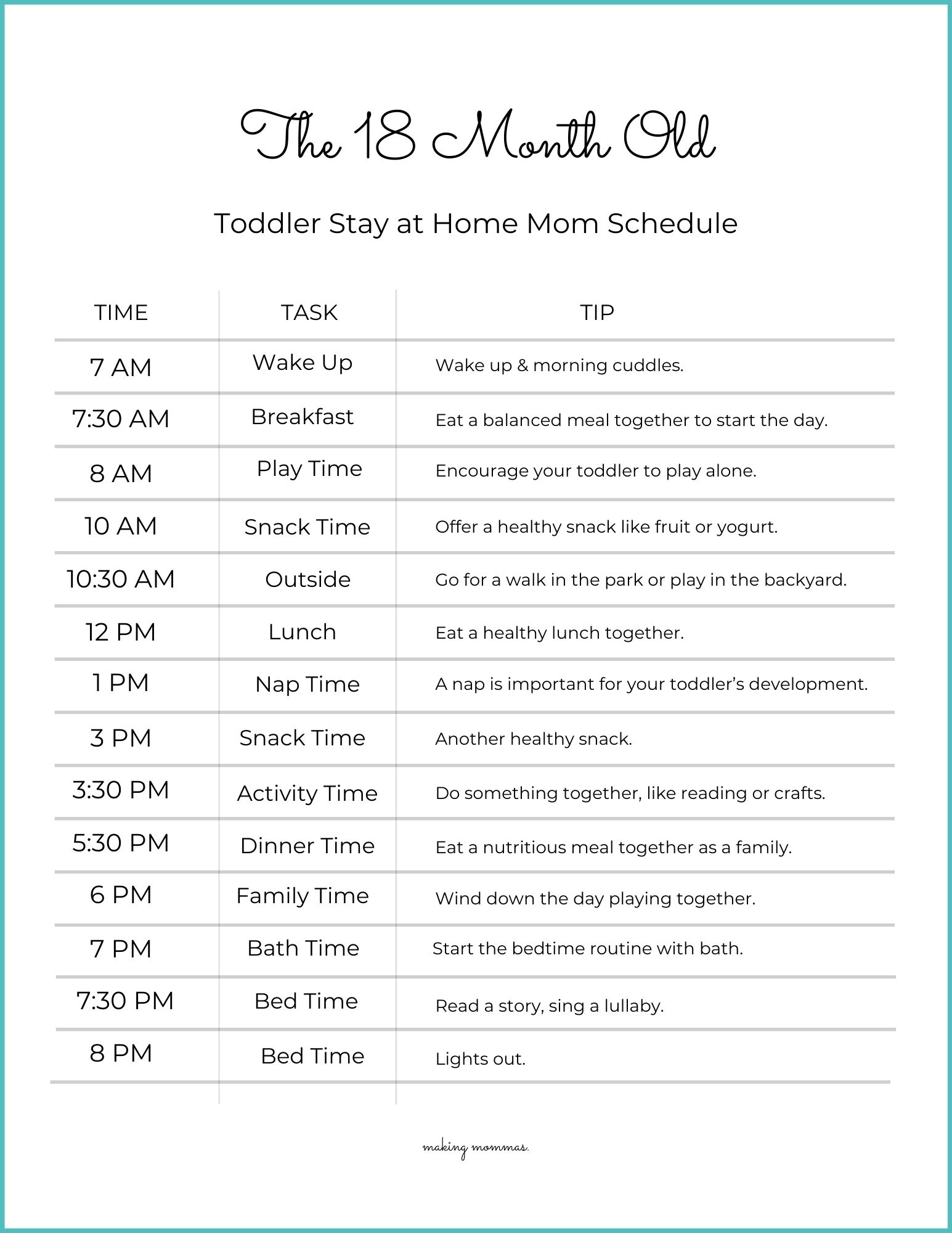
Here’s an example schedule for an 18-month-old toddler:
7:00 AM: Wake up and morning cuddles.
7:30 AM: Breakfast – a balanced meal to kick-start the day.
8:00 AM: Play time – encourage your toddler to explore their toys and environment.
10:00 AM: Morning snack – offer a healthy snack like sliced fruits or yogurt.
10:30 AM: Outdoor activity – a walk in the park, playground visit or simply playing in the backyard.
12:00 PM: Lunch – focus on a variety of nutrient-rich foods.
1:00 PM: Nap time – a good nap is crucial for your toddler’s growth and development.
3:00 PM: Afternoon snack – opt for a snack that’s both nutritious and appealing.
3:30 PM: Structured activity – this could include reading, crafts, or interactive games.
5:30 PM: Dinner – another chance to provide a variety of wholesome foods.
6:00 PM: Family time- winding down the day with quiet play time together
7:00 PM: Start the bedtime routine – bath, teeth brushing, pajamas.
7:30 PM: Bedtime story or lullaby – a calming activity to prepare for sleep.
8:00 PM: Bedtime – lights out and time for your child’s sleep routine.
Remember, every child is unique, and this schedule might need adjustments to suit your toddler’s individual needs.
Above all, maintaining consistent meal and sleep times are crucial for providing a sense of security and routine.
Sample Stay at Home Schedule for 2 Year Old
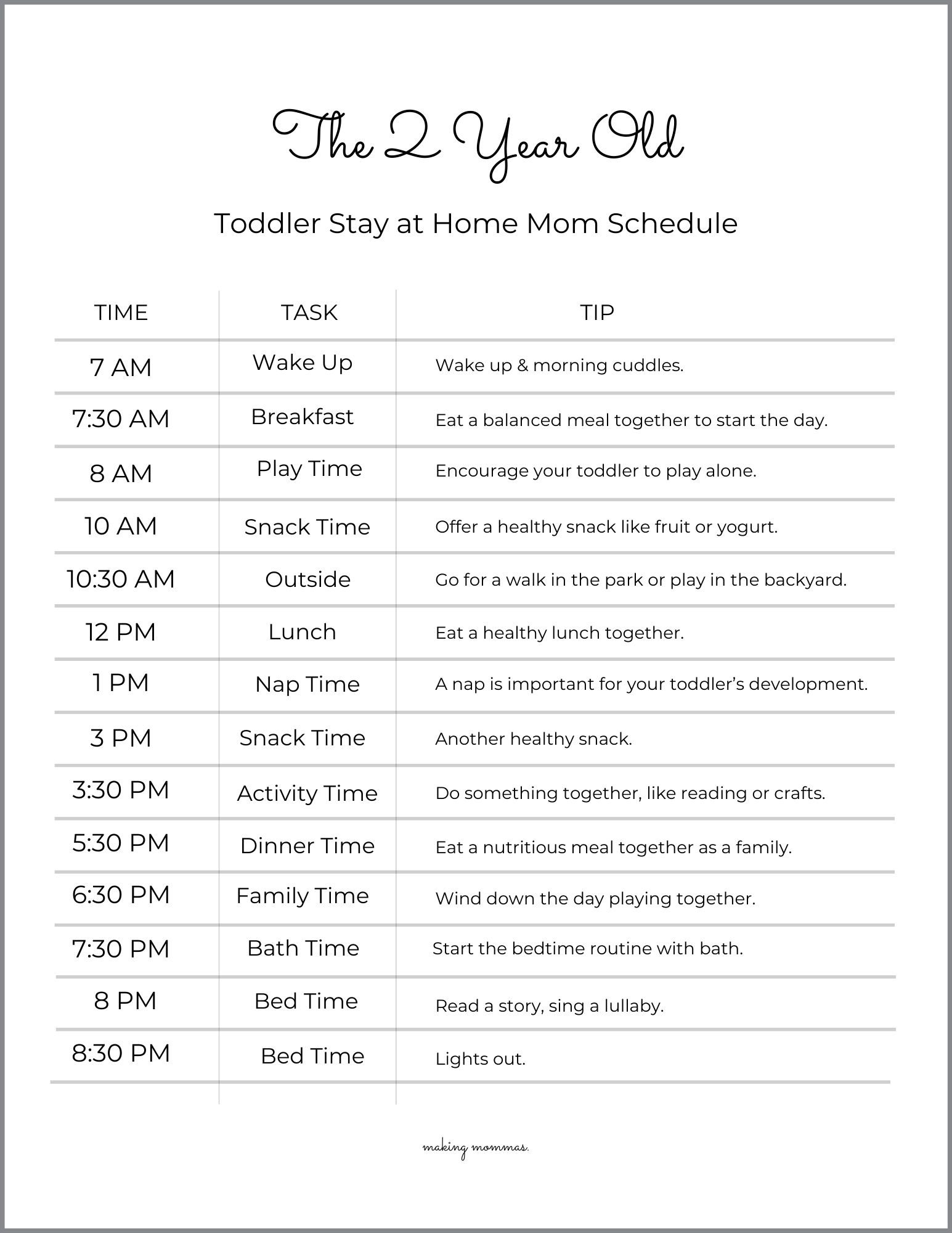
Here’s a potential routine for a two-year-old child:
7:00 AM: Wake up and morning cuddles.
7:30 AM: Breakfast – a nutritious meal to start the day.
8:00 AM: Free play – allowing your toddler to explore their toys and surroundings independently.
10:00 AM: Morning snack – a healthy snack like cut-up fruits or whole grain crackers.
10:30 AM: Outdoor activity – time at the playground, a walk, or simple backyard play.
12:00 PM: Lunch – offering a meal that contains a variety of nutrient-dense foods.
1:00 PM: Nap time – a nap is important for the overall health and well-being of your child.
3:00 PM: Afternoon snack – a snack that’s both healthy and appealing.
3:30 PM: Structured activity – could include reading together, arts and crafts, or interactive educational games.
5:30 PM: Dinner – another meal opportunity to provide a range of wholesome foods.
6:30 PM: Free play – winding down the day with relaxed play activities.
7:30 PM: Start the bedtime routine – bath, teeth brushing, getting into pajamas.
8:00 PM: Bedtime story or lullaby – a calming activity to prepare your little one for sleep.
8:30 PM: Bedtime – lights out and time for sleep.
As with any schedule, this is a suggestion and might need modifications to fit your two-year-old’s unique needs and rhythms.
Sample Schedule for 3 Year Old
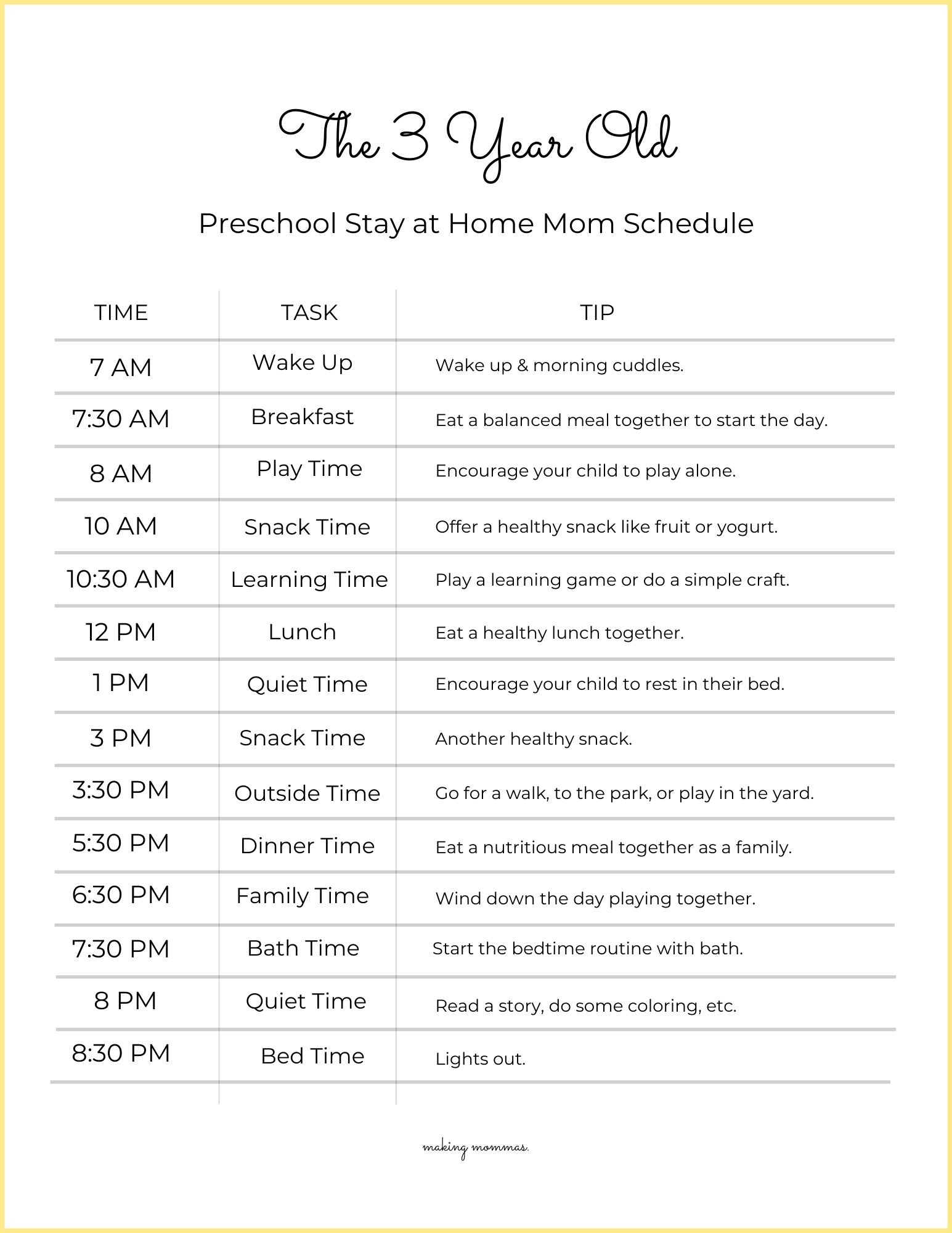
Here’s a suggested daily schedule for a three-year-old child:
7:00 AM: Wake up and morning cuddles.
7:30 AM: Breakfast – a hearty start to the day.
8:00 AM: Independent play – allowing your child to use their imagination with their favorite toys.
10:00 AM: Morning snack – a healthy snack like vegetable sticks or a small yogurt.
10:30 AM: Educational activity – this could be a fun learning game or a simple DIY craft.
12:00 PM: Lunch – offer a balanced meal to refuel their energy.
1:00 PM: Nap time – becuase some three year olds start to phase out naps, quiet time instead of afternoon naps can be beneficial.
3:00 PM: Afternoon snack – a small snack to keep their energy levels up.
3:30 PM: Outdoor activity – a visit to a local park or a bike ride around the neighborhood.
5:30 PM: Dinner – a well-rounded meal that includes all major food groups.
6:30 PM: Free play – allow them to wind down with their choice of activity.
7:30 PM: Start the bedtime routine – bath, brushing teeth, getting into pajamas.
8:00 PM: Quiet activities – this could include reading a story, singing a lullaby, or gentle play.
8:30 PM: Bedtime – lights out and time for rest.
This schedule is only a guideline, and flexibility is key. Every three-year-old is unique, and their routine should correlate with their individual needs and energy levels.
How to Write Down Your Own Stay at Home Mom Schedule

When you’re putting together your own stay-at-home mom schedule, it’s important to keep in mind that every family has different needs. But don’t worry, I’ve got some general steps you can follow to create a schedule that’s just right for you!
1. Identify Key Activities: Start by listing out all the essential tasks and activities that need to be completed daily. These could include meal times, nap times, errands you have to run, and appointments.
2. Set Time Frames: Once you have your list, assign each activity a time frame. Be mindful of your child’s patterns, such as when they usually get tired or hungry. It’s best to avoid running errands at nap time, for instance.
3. Add Enriching Activities: Fill up the rest of your time with awesome activities! Once you’ve scheduled the important stuff, make sure to add some fun and educational activities to the mix. It could be a combination of playing games, getting creative with painting or crafts, reading together, or even exploring interactive learning games.
4. Include Personal Time: It’s vital to include time for yourself in the schedule. Whether that’s a quiet cup of coffee in the morning, a workout during nap time, or some relaxation time after bedtime.
5. Prioritize Flexibility: Don’t stress about sticking to the schedule rigidly. Children are unpredictable and plans can change swiftly. The schedule should merely serve as a guide to help structure your day.
5. Reevaluate and Adjust: Finally, review your schedule after a week or so. Is it working as planned? If not, make adjustments as necessary. Remember, the goal is to create a rhythm that makes your life easier, not more complicated.
Using these steps, you can create a schedule that supports your family’s needs while maintaining a sense of structure and balance.
Tips for Creating a Stay at Home Mom Schedule for Toddlers

Now that we understand the general methodology of creating a stay-at-home mom schedule, let’s talk about some specific strategies stay at home moms can use to to create a toddler schedule.
This stage of a child’s life is marked by rapid development and curiosity, requiring a unique approach.
Here’s a few things I’ve learned over the years, to help you create your toddler schedule:
Use a routine instead of a schedule: Toddlers thrive on routines rather than strict schedules. There are so many awesome benefits to implementing a routine for your child!
Create rituals: Incorporate rituals into your routine to help your child transition between activities. For example, using a specific song for nap time or reading a book before bedtime.
Use natural transition points: Toddlers have shorter attention spans and can’t stick to one activity very long. To create a good routine, start with natural transition points in your day, such as when you eat breakfast, lunch or eat dinner, and then chunk your day down from there.
Stay consistent: Stick to your routine as much as possible, but don’t be too hard on yourself if things don’t always go according to plan. Toddlers are unpredictable! 😂🤣
Play – a lot: Playing is essential for a toddler’s development, so make sure to include plenty of time to play in your schedule. Your toddler needs structured play, free play, and time to play independently. This will give you some downtime to catch up on household tasks or take a break.
Know your family values: When creating a schedule, keep in mind your family’s values and priorities. If quality time is important to you, make sure to include dedicated blocks of time for this in your routine.
Consider the mornings and evenings: Having a pre-morning routine is crucial for moms to carve out some quiet time and ensure a smoother start to the day. Likewise, an evening routine allows mom and dad to have some time together and unwind before sleep.
Model your day after a daycare: Daycares and preschools have these amazing routines that give kids consistency and a sense of familiarity. If you’re a stay-at-home mom, you can totally create a similar routineat home too! It really helps your child grow, learn, and develop important skills that’ll benefit them for life. So worth it!
Creating your own schedule for your toddler might seem overwhelming at first. But trust me, with a little patience and consistency, it can bring a sense of predictability and comfort to your child’s day.
Don’t forget to stay flexible though, as their needs change and grow.
And most importantly, make sure your routine is filled with lots of fun, love, and laughter because they’re only little once, right? 🥰
Sahm FAQs

As we tippy toe down this rewarding, yet incredibly challenging journey of being a stay-at-home mom, we often find ourselves with questions. You know, stuff like coping strategies, setting up routines, managing time, and taking care of ourselves while looking after a toddler. 🤷🏻♀️
It’s no small feat, to say the least!
But guess what? I’ve got you covered!
In the next section, I’ve put together a list of frequently asked questions (FAQs) along with their answers.
Consider it your go-to guide for this amazing phase of life. 😉
What is a good schedule for an 18 month old?

The ideal toddler schedule understands an 18-month-old’s unique needs and preferences. It’s like a personalized routine just for them!
So, a good toddler schedule will usually start when your baby wakes up in the morning. Enjoy some quiet snuggles together, and then encourage your toddler to play quietly or have some quiet screen time while you get breakfast ready.
Then eat breakfast, get those teeth brushed, and get ready for the busy day ahead! Your toddler should spend the majority of the day playing. They can have fun with educational toys or enjoy some outdoor activities.
As the day goes on, it’s good to have some quiet time or naps to help them rest and recharge. Not all toddlers will fall asleep in the afternoon, but it’s still good to set aside that quiet rest time.
After nap comes more time to play!
In the evening, it’s dinner time followed by a relaxing bath and a cozy bedtime story. And then, it’s off to dreamland for a good night’s sleep.
Remember, this is just a general guide. Every child is different, so it’s important to adapt and adjust the schedule to what works best for your little one.
How do I entertain my 18 month old working from home?

Working from home with an 18-month-old can be quite a challenge, but no worries! With a little creativity, and a lot of consistency, you can make it work, promise.
I’ve learned that it works best to set aside time for your kids first, before attempting to squeeze in a little work time.
It also helps to encourage independent play. At 18 months, it’s the perfect time to start teaching kids to play by themselves. Offer structured playtime, provide educational toys, and create kid-friendly spaces.
Don’t forget to enjoy some outdoor time together too!
Your child is still quite young at this age and cannot entertain themselves for very long. So you will need to learn how to work in little bursts of time. I’d utilize nap time and early mornings/late evenings, as well.
What is a good daily schedule for a toddler?

A solid daily routine for a toddler includes a mix of structured activities, playtime, and plenty of rest. It’s crucial to tailor the schedule to fit each child’s individual needs and rhythms.
Staying flexible and making adjustments as necessary ensures the little one’s comfort and happiness.
How can I work full time at home with my toddler?

Working from home full-time with a toddler can be quite a challenge, but with the right strategy and planning, it’s totally manageable!
Here are a few tips: create a dedicated workspace, stick to a schedule, share responsibilities, keep expectations realistic, leverage technology, and keep your little one engaged.
Remember, every family is unique, so find what works best for you and make sure to take breaks for some quality time with your little munchkin!
What is a good schedule for a 2 year old?

A basic schedule for a 2-year-old involves balancing various activities like eating, playing, learning, and resting. Consistency is key to help your toddler understand and anticipate what comes next.
Remember, every child is different, so adjust the schedule to suit your child’s specific needs.
How can I be the best mom for my 2 year old?

Being the best mom for your 2-year-old is all about love, patience, consistency, and getting involved.
Create a nurturing environment that sparks curiosity and learning.
Make sure to spend lots of time with your little one, playing, reading, or just chatting. Try out activities that boost their development.
Stick to routines and discipline to give them a sense of security.
And remember, flexibility and patience are key as your child explores and learns.
When they do something great, don’t forget to give them praise and rewards. And when things get challenging, handle it calmly and constructively.
What is a good daily schedule for a 3 year old?

A good daily schedule for a 3-year-old should include a balance between structured activities and free play, along with essential elements like meals, nap time, and rest. It’s important to provide opportunities for physical activity, creative play, and ample rest.
The schedule can be customized based on your child’s needs and your family routine, while maintaining consistency and flexibility.
How can I be the best mom for my 3 year old?

Being the best mom for your 3-year-old is all about creating a loving, supportive, and super fun environment! Communication is key – chat and listen to your child, show interest in their thoughts and feelings.
Don’t forget to be patient and consistent with discipline, setting clear boundaries and expectations. Let their curiosity shine by giving them lots of different learning experiences and nurturing their interests.
Stick to a healthy routine, but be flexible when they need it.
Make sure to spend quality family time together, have a blast with play-based learning, and read to them every day to boost their language and cognitive skills.
Remember, every kiddo is unique, so what works for one might not work for another. Your love, understanding, and positive vibes are super important in shaping your child’s growth and development.
What is a good bedtime routine for a 3 year old?

When it comes to a good bedtime routine for a 3-year-old, it’s all about creating a calm and relaxing rituals.
So, start off with a nice warm bath and getting them into their cozy pajamas.
Then, you can enjoy some quiet time together, like reading a bedtime story or listening to some soft music.
Oh, don’t forget to dim the lights, adjust the room temperature, and snuggle them in with their favorite toy or blanket. Setting the mood for bedtime can go a long way to helping them wind down and relax.
And of course, a warm goodnight hug and kiss is a must!
Consistency is key in establishing their internal body clock, making bedtime a smoother process over time.
At the End of the Day…

Parenting is a journey that comes with both joys and challenges.
Creating a daily schedule for your 18-month-old might initially seem daunting, but with patience, consistency, and lots of love, it can eventually become second nature.
Remember, every child is unique, so it’s essential to be flexible and adjust the routine as needed to suit your little one’s needs.
At the end of the day, a well-structured routine not only provides a sense of security for your child, but also helps you, as a parent, manage your day more effectively.
So enjoy this beautiful phase of your child’s growth and cherish every moment!
Each day is a new opportunity for exploration, learning, and most importantly, creating memories.
Before You Go!
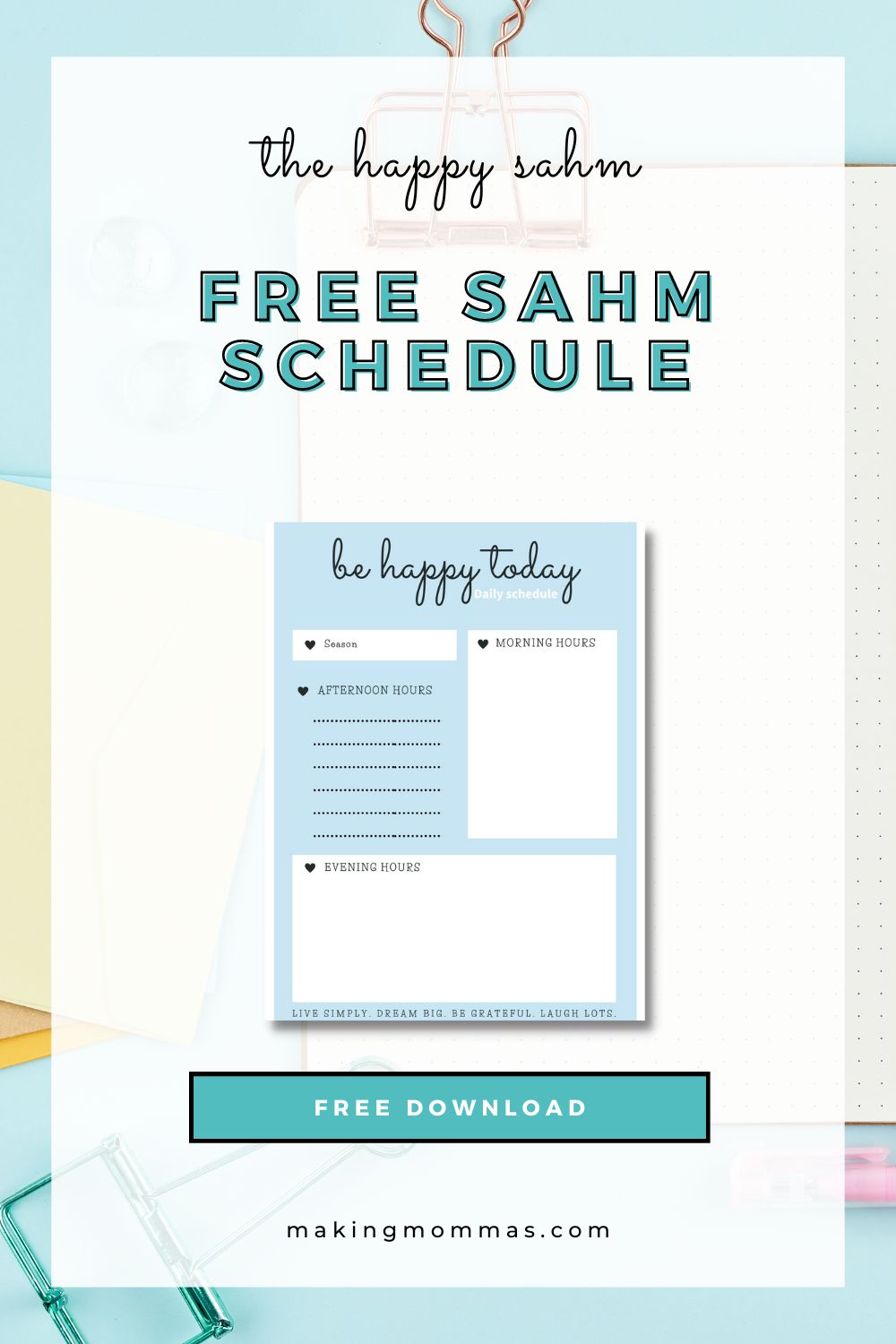
Before you leave, make sure to check out my free printable schedule – available for you download, to help you organize your day-to-day activities and make parenting a tad bit easier!
Click HERE to grab your copy now, and pave the way for a smoother, more structured routine with your little one.
Stay organized, stay on track, and keep enjoying this beautiful journey called parenthood!
More on Stay at Home Mom Schedules
How to Create a SAHM Schedule + Free Printable Stay-at-Home Mom Schedule
Wanna Create the Best Ever Stay at Home Mom Schedule? Here’s How!
How to Create a Daily Schedule for Stay at Home Moms of Toddlers
